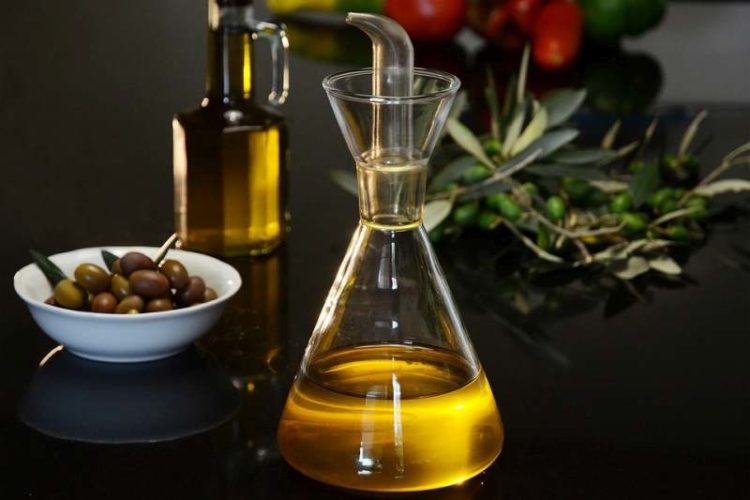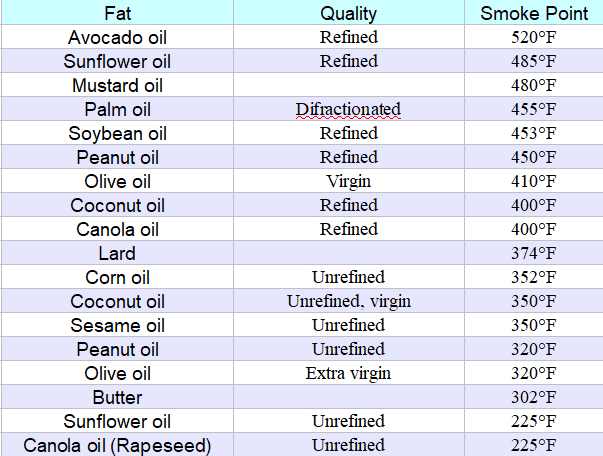When searing a cut of meat to give it some roast flavors before it goes into the slow cooker, it can get quite hot in the pan. Not all cooking oils can withstand high temperatures equally good. When oil overheats it loses taste as its ingredients oxidize and disintegrate. As a result, dangerous toxic substances are created. You want to know which cooking oil is best for you, what is the oils smoke point and what types of fatty acids there are.
Which cooking oil is best for you?
The temperature a cooking oil can withstand depends on the oil’s heat tolerance also known as Smoke Point. This is simply the temperature at which the oil or fat visibly begins to smoke. The smoke is created by the fact that the individual fatty acids begin to oxidize and disintegrate. This produces a number of new substances one of them the toxic Acrolein which is responsible for the typical acrid smell that comes with burned oil.
The different Fatty Acids in cooking oil
Saturated fatty acids
Saturated fatty acids are more common in animal foods such as meats, lard, cheese, butter, and other whole-milk dairy products. But they are also found in some vegetable products like coconut oil and palm kernel oil. Saturated fatty acids are more heat stable than any other fatty acids and have a high smoke point. However, saturated fatty acids have long been recognized as the cause of cardiovascular diseases and other health problems. Consume in moderation.
Monounsaturated Fatty Acids
They are considered good fatty acids as they are not suspected of causing health problems. Monounsaturated fats are found in red meat, whole milk products, nuts, and high-fat fruits such as olives and avocados. Other sources include nuts like peanuts, macadamia, sesame oil sunflower oil, and others. While they are not quite as heat-stable as saturated fats, they are much more stable than polyunsaturated fatty acids.
Polyunsaturated fatty acids
Oils with a high content of polyunsaturated fatty acids begin to oxidize and decompose at temperatures as low as 340 ° F (175° C) and form harmful aldehydes. They should therefore not be heated and are best consumed at room temperature with salads and dressings.

Refined, Unrefined, Cold-pressed or Native?
These terms keep on coming up when talking about the oils we use in the kitchen. But which cooking oil is best for you.
Refined oil
The oil is mechanically extracted at temperatures of around 220 ° Fahrenheit. In addition solvents and additives may be used to increase yield. Fatty acids become modified, due to the higher purity, the smoke point of refined oils is higher, which makes them more suitable for frying at high temperatures. The refined oil is largely tasteless, of light color, long-lasting, and universally applicable. Refined oils should be consumed in moderation because of the involved chemical extraction processes and alterations to the fatty acids.
Unrefined oil
The raw plant or oilseed is cold-pressed, a low heat input during pressing up to 60 ° C is possible. To increase the durability, these oils are partially steamed. During damping, as with refining, desirable accompanying substances are reduced.
Cold-pressed
By mechanically applying pressure oil is extracted from the seeds, fruits, or the plant material that contains the oil. Subsequently, the oil may be purified by filtration, but otherwise remains untreated. If the oil is additionally be referred to as “Native” if the seed or nut has not been pretreated mechanically like being crushed or roasted. Cold-pressed oils are produced without heat supply only by pressure or friction in mostly decentralized oil mills. The pressing is usually followed by filtration. The oils contain all ingredients. These have a positive influence on quality criteria such as taste, smell, color, and vitamin content.
Native oil
Native oils are natural and cold-pressed without additional heat. The cold pressing without heat prevents oxidation. The oil is filtered. Neither oil nor raw materials are pre- or post-treated, for example by refining, damping, or roasting the seeds. All ingredients are retained. Native oil retains the characteristic taste and smell of the oil plant. They are best consumed cold and are ideal for refining salads and dressings
Uses of the most common cooking oils
Below is a brief overview of which cooking oil is best for you to be used a what temperature. When cooking meals in a slow cooker you could use any oil as the slow cooker temperatures do not exceed 200 degrees Fahrenheit which is well below the smoke point of any cooking oil. Without having to worry about high cooking temperatures you can select the healthiest cooking oils. You may want to spend attention when browning meat before putting it in the slow cooker.

